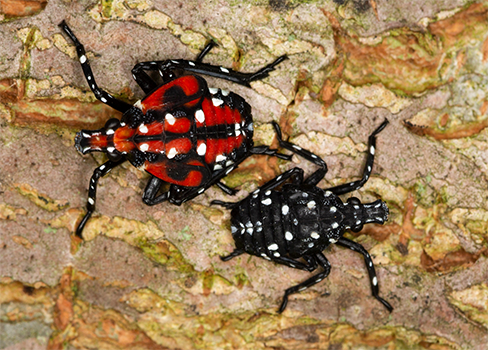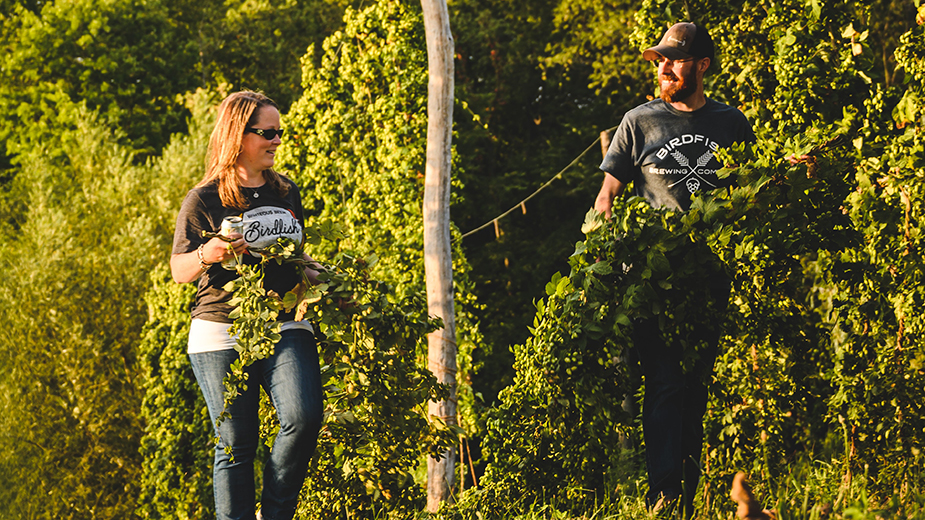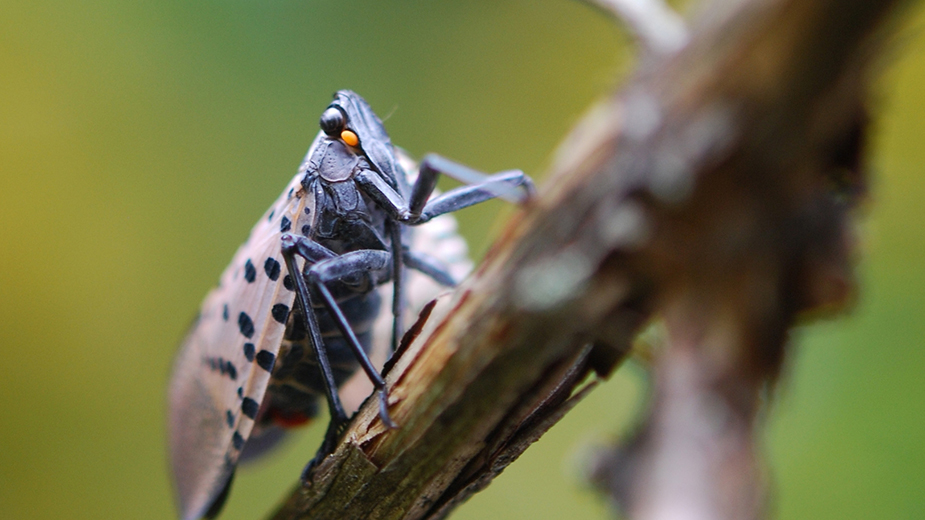Growers on Guard Against Spotted Lanternfly
YOUNGSTOWN, Ohio – The bad news is the spotted lanternfly – an invasive insect with an appetite for grape and hop plants – has arrived in the Mahoning Valley.
The good news is the pest is easily controlled and poses no major threat to the region’s wine and beer industries.
The bug with the colorful markings arrived in the United States in 2014, getting its first foothold in southeastern Pennsylvania. A native of China, India and Vietnam, it likely hitched a ride on a cargo freighter that docked in Philadelphia.
It has spread since then, establishing populations along the East Coast and in Ohio, Michigan and Indiana.
Its first appearance in Mahoning County was announced in early August by the state agriculture department. Infestations already existed in the Columbus, Cleveland, Sandusky, Cincinnati, Zanesville and Toledo areas.
The insect is a planthopper, and not much of a flyer. But it’s an effective hitchhiker that can hang on to a fast-moving truck or train for long distances.
Its infestations in Ohio and elsewhere are almost always in the vicinity of truck stops or along rail lines.
The fly does not feed directly on grapes and hops, but on the sap of those plants. In doing so, it weakens the plant and makes it susceptible to disease, eventually killing it.
The spotted lanternfly has not yet been found in the vineyards of the Grand River Valley viticultural area in Ashtabula County, easily the most important wine region in northeastern Ohio.
Instead, it is spreading fastest along the rail lines and interstates between Cleveland and Toledo, according to Maria Smith, viticulture expert for the Ohio State University Extension office in Wooster.
In Mahoning County, the infestation is in Austintown, in the vicinity of Webb Road, off state Route 46 just north of the Interstate 80 interchange, according to Jonathan Shields, manager of the spotted lanternfly program of the state agriculture department.
A Pilot truck stop is adjacent to the infestation site.
“The insects can get inside wheel wells and around license plates,” Shields says. “And they can hold on at high speeds. We’ve seen cases where they were on an open mesh container on a truck and held on for hundreds of miles.”
The insects seem to like rusty metal, such as might be found on a rail car, and can stick their egg masses to it, according to Shields.
In counties where actively reproducing populations have been found, the ag department asks property owners to regularly inspect their vehicles and eradicate the insects and their egg masses before driving and then report their location to the agriculture department at Agri.Ohio.gov/slf.
The spotted lanternfly has a distinctive look that makes it easy to spot.
It begins life as a nymph with no wings and an all-black body with white spots. In the adult stage, it is roughly one inch long and has gray outer wings with black spots, and underwings with red, black and white coloring.
CONTROL MEASURES
Fortunately, the pests can be controlled with existing pre-harvest insecticides.
“In Pennsylvania, they have been looking at exclusion netting, which is a nonchemical option,” Smith says. “It uses nets to cover the vines instead of spraying them.”

No grape vines in Ohio have thus far been killed by the spotted lanternfly. “But in northern Ohio, the first place will be in the Sandusky area, Huron County,” Smith predicts. “That’s where they are spreading the fastest.”
It’s difficult to predict the rate of spread, say both experts.
While the pest has not yet been spotted in the extensive vineyards of the Grand River Valley, Smith cautions that they could already be there. Train lines and Interstate 90 run through the area.
“It takes a concerted search to find them,” Smith says, noting that the bugs are “all over the place in downtown Cleveland.”
The insect has a yearlong life cycle.
“They overwinter as eggs on a tree, covered in a waxy coating that is white and gray that looks like Silly Putty,” the state ag department’s Shields says. “When it dries, it looks like dried mud.”
The cold Ohio winter will not likely kill the eggs, he notes.
The nymphs hatch in the spring, become adults in the summer, and produce eggs in the fall.
“There is one generation per year,” he says, adding “we will likely start seeing egg masses soon.”
The state has already conferred with grape growers to form a battle plan. “We’ve done quite a bit of outreach,” Shields says.
The ag department has had only one spotting of the insect in a vineyard. “There already is a treatment regimen in place and [the fly] is reasonably susceptible to it,” he says. “But we may not be able to eliminate them completely, and it has to be continuous effort.”
The ag department has formed an ad hoc group of growers, extension agents and other stakeholders to combat the invader.
“We share information,” Shields says, noting that information displays, with take-home brochures, are being placed in winery tasting rooms to get wine drinkers involved in the effort.
“We’re also working with railroad companies to improve awareness,” he says.
The spotted lanternfly seems to have no interest in the major cash crops of Ohio, such as corn and beans.
Its favorite feast might be the tree of heaven, Shields says.
“Tree of heaven is also an invasive plant, a tree which has been here for a long time,” he says. “It has a tropical look and was used in landscaping.”
ON THE FRONT LINES
Alex Heintzelman owns and operates a small hop farm in the Greenford area of Mahoning County.
He’s vigilant for signs of spotted lanternfly infestation but has yet to see the pest on his property.
He’s attended informational sessions on the fly at agricultural conferences. “It’s a threat, and it doesn’t have many natural predators,” Heintzelman says.

Hop farming is not Heintzelman’s primary business; he’s actually a medical doctor with a family practice office in Columbiana.
But he worries about those whose livelihoods depend solely on producing hops and grapes.
“It’s already difficult to grow hops in our area because of our humid climate,” he says.
Like the grape, the hop plant is a fruit. Its long stem, known as a bine, grows vertically along twine that is strung along a frame. And like the grape, cultivation of the plant is labor-intensive and at the mercy of the weather.
The flower of the hop plant is the part used in beer making.
Heintzelman also cultivates fruit on his 16-acre parcel and is also a beekeeper.
While hops comprise a very small percentage of Heintzelman’s farm, it’s the only crop that he sells. His customers include Birdfish Brewing in Columbiana and Modern Methods Brewing in Warren.
Hops are harvested from mid-August to early September, while grapes are harvested in September and early October.
The Ohio Wine Producers Association, an industry group based in Geneva, is being very active in dealing with the insect. “The spotted lanternfly is not yet in the Grand River Valley, but everyone is on high alert,” says Donniella Winchell, director.
Kent State University’s Ashtabula campus has done “a whole lot of research” on the pest, she says. The campus offers certificate programs in winemaking, viticulture and brewing.
The Grand River Valley viticultural area runs along state Route 307 and parallel to the Grand River in northern Ashtabula County. More than 30 wineries are located in the region, with over 400 acres of grapes being cultivated.
Winchell says vigilance is the key to controlling the fly.
“Strict attention must be paid [to the insect’s locations],” she says. “Once the pest is identified, wineries use conventional insecticide sprays to control it. The problem is, it has to be identified quickly because they reproduce rapidly.”
Getting the wine-loving consumer to also be on the lookout will make it more likely that infestations are quickly spotted and eradicated, she says.
“It sounds as though it will be easy. But it won’t be so easy because they move in quickly,” Winchell says. “Our wineries are extremely vigilant and concerned that we stay on top of this.”
While the spotted lanternfly likes to feast on grape and hop plants, it also has a taste for certain fruit trees, including apples, says the ag department’s Shields.
But there is not a lot of concern at White House Fruit Farm near Canfield, which has an apple orchard.
“It hasn’t affected us here,” says Dave Hull of White House. “As far as what it may do or how to control it… we’re just going to have to wait and see. From what we’re being told at meetings, we do not expect any major damage, or really any damage.”
Pictured at top: The adult spotted lanternfly is about an inch long and has brown wings with black spots and an underwing with red markings. (Photo by Ohio Department of Agriculture)
Copyright 2024 The Business Journal, Youngstown, Ohio.



